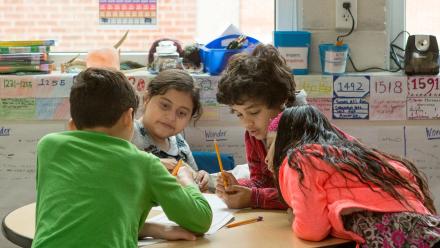Narrator: At Springhill Lake Elementary in Greenbelt, Maryland, a class of third graders is living in a real fantasy world.
Aracely: There’s a big castle and you can hear birds singing and you can only drive limos.
Narrator: In actuality these students are getting a very grounded education in writing thanks to their teacher Ms. Sterkin.
Sterkin: It was little scary at first to teach writing because of all the different layers that go into writing. There’s mechanics, and ideas, and purpose, and audience, and genre, and then on top of that, you want them to be able to express themselves in a really interesting way for their readers. But every single year, I learn something new to help them to just keep layering their skill level in writing.
Narrator: Ms. Sterkin set a solid base for this scaffolding by creating a classroom environment where writing is fully integrated into the day.
Graham: When you take a look at elementary schools and the state of writing instruction, there’s two things that stand out. One, there’s very little writing going on by kids. Second, there’s very little instruction writing going on.
Sterkin: Okay, you can begin.
Narrator: Ms. Sterkin is determined to make sure her class is an exception. For example, to keep her students writing every day, Ms. Sterkin had each of them create a writers notebook. In it, they can brainstorm and draft ideas, which they can then share with the class.
Student: The house is red and white. Outside is quiet and peaceful.
Sterkin: The first week of school, we start with their own writer’s notebooks. We talk about the kind of space they need as a writer. We talk about the tools. And we also give them a lot of time to share, so that they’re comfortable sharing their writing and when it’s time for them to go through the revision process, they know that they’re able to share in a way that isn’t really scary for them.
Sterkin: Yes. What are some things you like about Mohammed’s details? What’d you like, Daira?
Daira: That it smells like strawberry and flowers.
Sterkin: Yeah. Wasn’t that a really good detail. It really helped us visualize with our five senses what it’s like there. Nina, what did you like about Mohammed’s?
Nina: I like about Mohammed’s that he kinda added a little bit part of poetry.
Narrator: And it’s not just the students who take part.
Christian: Ms. Sterkin, would you like to share?
Sterkin: Yes, Christian, I’d love to, thanks.
Narrator: Writing teachers need to see themselves as writers too.
Rogers: Teachers of writing must write. You have to be confronting both the satisfactions and the challenges of the writers task and then modeling that for your students. Being willing to show them a piece of writing that you have to fix and revise. You can’t just be one who assigns and grades.
Sterkin: Shimmering purple trails, led me to the journey to his kingdom. I might have to re-read that and make it sound a little better. With each step I took, purple sparkles swiftly scooted from beneath my feet. Swiftly scooted. That’s right. And what is it when I add two words together with the same beginning sound?
Student: Alliteration!
Sterkin: Alliteration. Good job.
Narrator: Besides creating regular writing opportunities for students, this workshopping provides a chance for them to give and receive feedback effectively.
Sterkin: I think the students cheer for each other because we would cheer for them when they share their own writing. And when we start in the beginning of the year, we would specifically find examples in the students writing that they should be proud of. And then we would invite the other students and specifically ask them, “what are some things you noticed in this person’s writing that you really think they did a great job on” and ” what are some of the things that maybe you can suggest that would make it more interesting as a reader”?
Narrator: After Ms. Sterkin’s class, these particular entries also acted as a pre-writing exercise for their unit on fairytales.
Sterkin: Okay, let’s talk about what we’re going to do today. Today we’re going to start writing our fairytales. And before we write our fairytale, we’re going to talk a little bit about what some really good writers do. We had some awesome examples of good writers in the last couple of days.
Narrator: Ms. Sterkin is referring to her use of mentor texts, which are pieces of writing whose idea, structure, or written craft can be used to inspire students own writing.
Sterkin: And we’re also going to read a story today called Crickwing. And it’s not a fairytale, but the author did something really special in that book that made the story sound exciting when we read it. And it helped us visualize what the characters in the story were doing. So we’re going to see what special trick that author used and we’re going to see if we can use it today in our fairytale writing too.
Hansen: The ideal way to look at the notion of mentor texts is that children, as readers, are noticing what they can use as writers., and finding mentor text that work for them.
Rogers: So it’s not just saying here’s a model text, everyone be Shakespeare. Here’s the perfect text — imitate it.
Student: Vivid.
Sterkin: Vivid verbs. When something is vivid, it’s really easy for us to see. So when we have a vivid verb, it’s easy for us to visualize it in our head. And in this story, Janell Cannon used a lot of vivid verbs. Tons of vivid verbs. I don’t think she used a whole lot of plain verbs. All of them are so easy for us to visualize in our head when we read her story. So, as we read, if you hear a vivid verb, I’d like you to hold up “V.” What is “V” for?
Students: Vivid verbs.
Sterkin: “Far below the great forest canopy lies a shadowy world that many insects call home. Among the damp clutter of fallen leaves and branches, leaf-cutting ants toil all day while large cockroaches await their evening search for food.” What did you hear? Nico, what did you hear?
Nico: Toil.
Sterkin: Toil. So if they’re toiling, what are they doing?
Students: Working hard.
Sterkin: Working really hard. Yes. We toil all day. “Pow! Swoosh! A sharp-eyed monkey clobbered Crickwing and swiped his sculpture.” What did we hear?
Students: Swiped.
Sterkin: Swiped. So if he swiped his sculpture, that means he did what?
Students: Took it.
Sterkin: He took it, but it didn’t just say he took it. How did he do that?
Students: Swiped.
Sterkin: What does it look like if you swiped it? I see you’re all moving with your arms very quickly. When you swipe something… She swiped it from me! Go ahead. Swipe it. She swiped the word swipe. Do it again so everybody can see. Swipe it. She did it fast. So we know that monkey was moving how?
Students: Fast.
Sterkin: Why do you think Jannell Cannon decided to use these special vivid verbs instead of plain old verbs?
Student: I think when she used vivid verbs, so her story, so it like, makes the story more interesting.
Sterkin: It sure does. Wasn’t the story more interesting when we can visualize the special way the character moved or felt.
Students: Yes.
Sterkin: Yeah. And now, at this point, we’re such good writers that we want our readers to be interested in the story just like you are interested in listening to Janell Cannon’s story. So we’re going to try to put some vivid verbs in our fairytales that we write today.
Narrator: Ms. Sterkin follows up the whole class work with more explicit instruction, in small groups. This gives Ms. Sterkin a chance to assess the students’ understanding of vivid verbs, while the students get a chance to practice with the text in a more intimate setting.
Sterkin: “I can’t do this, Eartha blurted as last.” If you blurt something out, what does it sound like?
Student: I can’t do this anymore! That’s exactly why I visualized that.
Sterkin: Perfect. If I say, in the classroom, Tylere blurted out the answer, what does it mean?
Student: Shout.
Student: Two!
Sterkin: What do you think?
Student: He just screams it out.
Sterkin: He just screams it out. So if Eartha blurted out “I can’t do this anymore,” what does she do?
Students: I can’t do this anymore!
Student: Like…just talk, talk.
Sterkin: Do you want me to keep talking? Are you the director now? Okay. So we’re talking about the word…
Student: Stop!
Sterkin: Ah! So, she blurts it, like and interruption.
Student: Yeah.
Sterkin: Good thinking. So, if she had just used the word “said” in the story, we would no visualize that she interrupted, but since she used that word “blurted”…That was a perfect reenactment of the word “blurted.” She interrupted us. I’d like you to read the rest of it by yourself. And I’d like you to find your vivid verbs just like we did together, and circle them, or you could put “VV’s” on them. And then I’d like you to find one that you think is a really beautiful example of how that vivid verb helped you make an inference about the character.
Narrator: Ms. Sterkin is giving the students multiple chances to work with this new material and varying her lessons between whole class, small groups, and individual instruction.
Sterkin: Did you find the one that you really feel like was a good example of a vivid verb?
Student: Quavered.
Sterkin: Quavered. You like that? So why do you like that one?
Student: Because, it’s like “shuttered.” And then this one is almost like this one.
Sterkin: So, what does it help you infer about that character?
Student: Maybe this one was nervous, maybe he’s nervous.
Sterkin: Mmm hmm. Yeah. Did they have something to be nervous about?
Student: Yeah.
Sterkin: Yeah, they do. So it’s a great way to help us visualize how the characters are feeling without just saying they felt nervous. It doesn’t even say the word nervous in there does it? But because she used special words, we can make these inferences by ourself, as a reader.
Narrator: For Ms. Sterkin, success with writing means creating a respectful community of writers.
Sterkin: I make sure I take the time to listen to listen to their concerns and make sure that, they feel like when I’m talking to them about their work that I’m not really criticizing what they’re doing, but that I’m there to help them. That we’re here to help each other. I learn from their ideas. I can take what they’re doing and share it with the rest of the class because they might have an idea that’s better than mine. And to do that frequently, so they know that this is just not, like, a one woman show in my classroom. We’re all learning together and helping each other.
Student: It doesn’t have “they lived happily ever after.”
Sterkin: Classic fairytale line, right? Yep. Let’s see.





